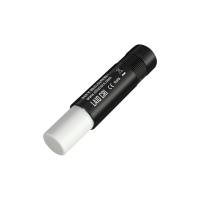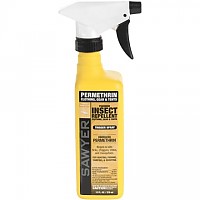CamelBak ShredBak
The ShredBak has been discontinued. If you're looking for something new, check out the best soft shell vests for 2024.

I first tried the new CamelBak ShredBak hydration system in January at the winter Outdoor Retailer show’s on-snow session, where I also tested numerous tele skis and the new Easton snowshoes. I wore the ShredBak in its full configuration of inner mesh vest attached to the outer softshell vest for about five hours of skiing downhill on the teles, going around the cross-country track on skate skis, and snowshoeing over a wide range of slopes both on and off trail.
CamelBak originally was to supply me with a ShredBak prototype in spring. Instead, they sent a women’s model, which clearly was not going to fit me, to Trailspace’s editor, Alicia MacLeay (read her ShredBak review).
In July, while I was at the summer OR show, a men’s medium ShredBak arrived for me. As soon as I returned from the show I tried it on, with some trepidation, since I normally take a large (due mainly to getting my shoulders built up during years of climbing and some gymnastics). However, the inner mesh vest that carries the hydration bladder has sufficient stretch that, while snug, is still comfortable, even when wearing the chest transmitter strap of one of my heart rate monitors.
I have now used the ShredBak, along with the new Leki Thermolite AERGON Antishock trekking poles (read my review) on a half dozen summer hikes, totaling perhaps 40 to 50 miles, and on several bike rides.
The ShredBak
Since we are in the midst of a summer that is featuring a lot of 80-90 degree days, I opted to wear the mesh vest only and not the soft shell outer vest. I will say that the outer vest is of high quality and should work very well during ski season, for which it is really intended. The inner-outer vest combination worked very well for me in January at the winter OR Show demo day.
The inner vest attaches to the outer soft shell vest with several loops and buttons. Since it is closed with a zipper, there is no apparent risk of the attachment system failing during wearing. In fact you could wear them separately, if you got too hot and needed to shed a layer.
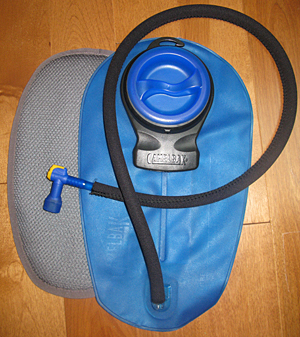
The ShredBak’s hydration reservoir with insulated tube cover and the removable foam insulation pad.
The 72-ounce bladder is a bit different from the usual CamelBak (or other company) hydration reservoirs. It is a different shape, shorter and wider, and has an internal divider to keep the bladder’s shape when partially empty. This also keeps the weight more uniformly distributed across your back. In case you put very cold fluids in the bladder (and against your back), there is a removable foam pad for insulation.
If I were to use it on my trips in subzero weather, I would be inclined to leave the foam pad out so that my body warmth could help prevent freezing of the contents, although when I have worn my CamelBak Classic in such conditions under my jacket and backpack, enough body heat got through the foam of the CamelBak’s pack to keep the contents from freezing.
In Use: Cycling
I wore the mesh vest and bladder on a number of hikes plus two bike rides, one of which was up the Bay Area’s infamous Old La Honda Road, a 3.5-mile climb ascending 2,500 feet, with a slope greater than 10 percent in places. This was a fairly hot day, though I was under redwoods the full distance up the hill.
As it happened, I chose the wrong day to go up OLH — there was an organized ride following much of the same route, with dozens of young hotshots passing the Old GreyBeard on the way up (Eric Heiden holds the record up the hill from a ride during his Olympic competition era at about 18 minutes — took me 36 minutes that day, twice as long as an Olympic champion in his prime).
During the ride, I wore the inner mesh ShredBak vest over my regular CoolMax jersey. At the summer OR Show, CamelBak was showing the new VeloBak, a cycling jersey with the same bladder in a pouch on the back; this piece will be much better suited to cycling.
In Use: Hiking
During the hikes, I wore the inner mesh vest over a wicking T-shirt and in one case over a wicking long-sleeve shirt. On a cross-country hike from Clair Tappaan Lodge at Donner Pass in the Sierra Nevada, I carried a fairly full pack with gear for the Sierra Club’s GPS workshop I was teaching. This included several extra loaner receivers, a rain jacket for those summer thunderstorms that too often come up in the mountains, lunch, the first aid kit that Sierra Club hike leaders are required to have along, and a bunch of required paperwork. This placed the vest and full bladder between my back and the pack.
For many years, in cold climates (Denali, Antarctica, backcountry ski tours) I have carried a CamelBak Classic hydration pack under my jacket with the hose running down my sleeve. I previously had asked CamelBak to consider something like the ShredBak for those of us who ski and climb in cold weather, since it would keep the hydration pack from freezing. Many of us who climb in such conditions have found this works well to keep hydrated despite subfreezing conditions that leave even water bottles inside jackets with ice crystals. So it was a delight to find this set-up really works and is much more comfortable than using the Classic.
On the hot hiking days, I did find my back getting wet from the heat and consequent sweating, just as with a regular hydration pack. I had worried about even the mesh vest adding to the heat burden, but found the added heat retention to be minimal. This is probably because the mesh allows sufficient transpiration.
Bottom Line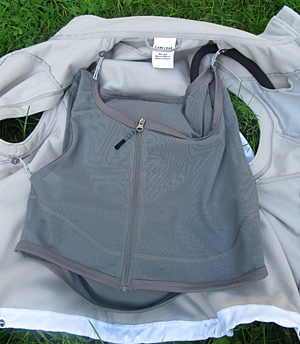
The inner mesh hydration vest attaches to the outer softshell vest with four loops and buttons. The hose passes through a left chest pocket.
The bottom line is that I found the ShredBak to be a good step forward for the winter traveler and for the summer hiker as well, with the mesh vest worn alone. It answers the need for a way to keep a hydration bladder from freezing in subzero conditions and is a more comfortable way to carry the bladder in summer.
CamelBak and the other hydration reservoir manufacturers have, in my opinion, been going too far toward the hydration pack with too many pockets and other excess fanciness added (and resulting in too much weight). I already have packs I like, and the ShredBak gives a better way, in my opinion, to have the pack and the hydration bladder.
There are some minor improvements needed, at least for my personal preferences. One is that the attachment of the inner mesh vest to the outer softshell vest seems a little iffy. The attachment is four loops of thin elastic cord tacked to the main seams of the mesh vest, which mate with four small buttons on the softshell.
My experience with small buttons like this is that they are somewhat awkward to button, especially with gloves on, plus the thread that attaches such buttons all too soon breaks. This would require a field repair, although you could put the inner and outer vests on separately (they do not have to be attached to one another). A more durable fastening mode would be desirable.
Another quibble is that, while the hose can be routed over either shoulder through the mesh vest, the outer softshell has only one pass-through, a storage pocket on the left side. In the medium I was sent for evaluation, this pocket just happens to lie at the level I usually have my main pack’s sternum strap. This is a little low for the bite valve for me, as well, plus I generally keep the hose on my regular hydration packs on the right. The mesh vest is designed so that the hose has to run over the shoulder, which causes a potential conflict with the straps of my full expedition pack (I am able to shift things around enough to avoid a problem, though). I would have preferred to run the hose under my arm and down the sleeve for severe cold weather usage.
These are minor quibbles that I can live with. The ShredBak is definitely a step in the right direction. It probably would have been better if they had sent me a large, though, since the medium softshell is a bit tight under the armpits and both vests are a bit tight around the chest and shoulders. Otherwise, it works pretty well, and is a good step forward in winter hydration.
ShredBak Specs
Weight:
Medium ShredBak vest: 410 g (men’s); 370 g (women’s)
Insert: 33 g
Complete reservoir: 145 g
Complete ShredBak with water: 2,510 g (men’s); 2,470 g (women’s)
MSRP: $200
Available: Fall 2009
Source: received for testing via the Trailspace Review Corps
(Sample provided by CamelBak for testing and review)
The soon-to-be-released CameBak ShredBak, a softshell vest with an integrated, removable, inner hydration layer, was the most interesting new product I saw at Outdoor Retailer Winter Market in January 2009.
Like many, I’m already a devotee of hydration reservoirs and packs for their convenience when hiking, backpacking, biking, and cross-country skiing. I also heard some very positive feedback from individuals who had the opportunity to test the ShredBak while skiing and riding at an Outdoor Retailer demo day in January.
So, I was eager to see how the pioneering piece would perform on the slopes when I got my hands on a sample in late-winter/early-spring 2009.
Construction
The ShredBak is CamelBak’s second piece of “hydration-integrated apparel,” following the RaceBak cycling hydration baselayer the company introduced in fall 2008. The VeloBak, a short-sleeve, integrated-hydration cycling jersey, will be introduced later this year.
The ShredBak’s outer softshell vest (100% polyester) is soft and stretchy with a fleecy interior lining. The waist has a drawcord with toggles for tightening. A small chest pocket on the left allows access to your reservoir’s bite valve.
Two zippered outer pockets and two open inner ones give you plenty of room to stow energy bars, a camera, phone, and other small items. If you need any significant gear storage, you’ll need a pack instead.
The second component of the ShredBak is an inner, mesh, compression vest (75% polymide, 25% elastane) that attaches to buttons inside the outer vest via four loops. It zips up in the front, and the back has a reservoir compartment, with removable pad, to hold a 72-ounce Omega Reservoir (included). The reservoir’s insulated tube threads out the top of the inner vest and directly into the exterior vest’s left chest pocket, from which you can easily access the bite valve.
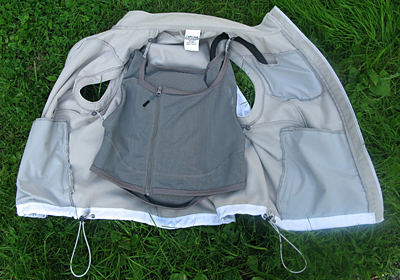
An open ShredBak shows the inner compression vest, attached to the lining.
Men’s and women’s models come in black or white, both with a pattern on the back, and starting with my initial impression, I thought the outer shell looked and felt quite comfortable and was fairly styling.
The ShredBak appears to be well constructed, and CamelBak’s popular Omega Reservoir has already been well tried and tested.
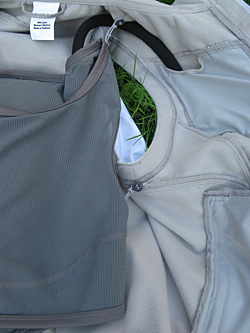
The inner mesh vest attaches to the outer softshell’s lining via buttons and loops. The reservoir tube feeds through the chest pocket.
Fit
According to CamelBak, the ShredBak is designed as a winter mid-layer to be worn over a baselayer, with the option of using it as a spring outer layer. It’s offered in fives men’s sizes (S-XXL, fit chests 35"-50") and five women’s sizes (XS-XL, fit chests 31"-44.5"), a sizable range for both genders.
I tested a women’s medium, fitting exactly in the middle of medium size measurements, and I immediately noticed that the inner vest was snug, very snug. This is coming from someone who already was wearing a sports bra.
However, the compression fit is where CamelBak’s big idea for “wearable hydration” comes into play. According to CamelBak, the inner compression vest is designed to encapsulate the reservoir, supporting and stabilizing the water weight on your back, while being low profile, aerodynamic, stable, and user-friendly for riding lifts.
So, the close fit is essential to CamelBak’s concept of truly wearing your hydration.
Unlike the outer vest with its drawcord, you cannot adjust the inner vest at all. So, you’ll either like the fit of ShredBak’s inner compression vest over your baselayer, or you won’t.
Sometimes I did, other times I didn’t. The inner vest’s tight fit occasionally bordered on constricting, particularly when I wore it on cold days, skiing hard for several hours, with a fleece top squeezed underneath. (CamelBak means it when they say the ShredBak is designed to fit over a baselayer.) This was my one recurring issue with the piece, and a potential deal breaker.
In comparison, the outer vest had an excellent fit; it was comfortable and roomy, but not baggy, with a nice, soft stretch. Alone it makes for a very nice softshell vest that can be layered over a base- and a mid-layer and worn as a mid- or outer layer.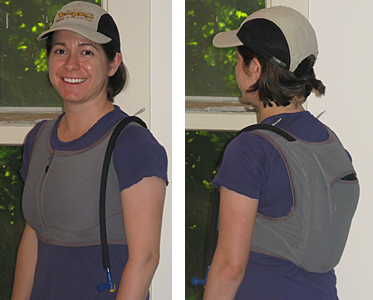
The inner compression vest is integral to offering “wearable hydration” in the ShredBak.
Function
In all fairness, while the insert’s overly snug fit was a nagging issue at times, I also had long spells when I completely forgot I was wearing the ShredBak, until I leaned back on the chairlift. If the compression fit is good for you, the ShredBak’s functionality will be too, with a few considerations to keep in mind.
While the ShredBak is lower-profile than an exterior hydration pack, wearing it underneath a shell can give you a resemblance to Quasimodo, without a hydration pack as visible evidence for your deformity. If you’re vain, you may want to avoid restroom mirrors.
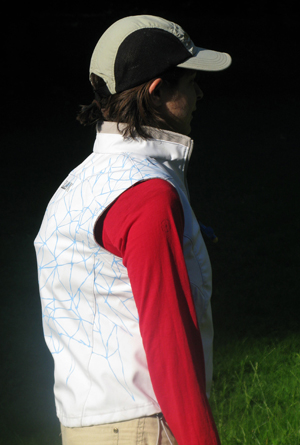
I initially worried about the bite valve opening inside the chest pocket and silently soaking me with cold water, but this never happened. The valve stayed secure. The bite valve’s location makes it easily accessible, without an outside tube getting in the way. It was nice to be able to zip everything out of the way when done, then access it again easily.
While CamelBak’s RaceBak is designed for cycling in warmer temperatures, the ShredBak obviously is designed for skiing and riding in winter conditions, i.e. colder temperatures. If you tend to run cold or it’s a brutal day, wearing 72 ounces of water against your back will not help you stay warm, though you will help keep your water from freezing. To combat this, you can fill your reservoir with warm water, but that can be unappealing for drinking and the water will eventually cool off anyway.
As noted above, the ShredBak is designed to be worn over a baselayer. Wearing a softshell with a fleecy inner surface and a mesh inner vest that’s filled with water, you’ll be trading off some room for inner insulation for the convenience and performance of a wearable hydration vest. For some individuals the trade-off will be worth it. If you run warm, are continuously moving, and want your water easily accessible and your clothes and hydration system streamlined and low profile, the ShredBak is definitely worth a look. But, if you’re a cold-blooded bundler or frequently out in very cold temps, this garment probably is not for you, at least not in the depths of winter.
I preferred the ShredBak as an outer layer on warm days, versus as a mid-layer in winter, and thought it best suited for bluebird, high-octane days, when it could really shine.
Value
Here is where the buyers and non-buyers will be separated.
The ShredBak will retail for $200. That $200 gets you a very nice softshell vest, the inner, mesh compression vest, and a 72-ounce (2.1-liter) Omega hydration reservoir with 37" Big Bite Valve and Ergo HydroLock.

For comparison’s sake, a softshell vest can cost $60 to $150. CamelBak hydration packs range from $45 to more than $100, with a basic CamelBak Classic 70-ounce hydration pack retailing for $45. However, a standard hydration pack, though it may offer more carrying capacity and other features, will not carry your water weight as securely or as well as the ShredBak. That’s the big difference.
As I sat in different base lodges or on chairlifts wearing my rather styling, integrated-hydration vest, I couldn’t help but notice the many hydration packs that other skiers and riders around me, from preschoolers to expert backcountry skiers, were wearing. Most of them seemed satisfied with their set-ups, often from CamelBak. So, I had to wonder if I—or any of them—really needed a fancy, integrated-hydration vest for skiing, no matter how good it looked or how well it performed.
So, is such a highly specialized product worth it? That’s the $200 question.
The CamelBak ShredBak can excel on the winter slopes for certain athletes in certain conditions. But, for those who want or need their gear to do double or triple duty it’s not as versatile as having a hydration pack for hiking, biking, and other outdoor pursuits in various conditions. If you’re already a multi-sport outdoorsperson, who has a hydration pack or two lying around that you think are “good enough,” the ShredBak probably is not for you. You won’t get the same level of aerodynamic stability and performance as from a ShredBak (provided it fits), but you’ll still stay hydrated and probably won’t care.
If you don’t mind a compression fit over your baselayer, are a serious skier or rider who wants an integrated, hydration setup on the slopes — more streamlined and lower profile than a separate hydration pack — and don’t need to carry gear or wear lots of extra insulation, the ShredBak’s performance edge and convenience may be worth $200.
Value is a personal judgment: if you think something is worth $200, then it is. If you don’t, then it isn’t.
Conclusion
Despite my concerns over the inner vest’s tight fit and the piece’s versatility and value, I’m still very intrigued by my ShredBak. The piece has great potential, was more comfortable than a hydration pack at times (provided I wasn’t cold and didn’t try to layer), and hey, it looks pretty cool too.
Ultimately the ShredBak is a specialty item and its value will depend on your outdoor activities, performance needs and wants, and discretionary income.
So, is the ShredBak necessary? No, but I can name a lot of other outdoor gear that isn’t strictly necessary either.
Is it nice to have? Yes.
When those beautiful, bluebird days hit next spring, I’ll be trying my ShredBak out on the slopes again.
ShredBak Specs
Weight:
Medium ShredBak vest: 410 g (men’s); 370 g (women’s)
Insert: 33 g
Complete reservoir: 145 g
Complete ShredBak with water: 2,510 g (men’s); 2,470 g (women’s)
[CamelBak supplied a sample of the ShredBak for testing and review.]
Source: received for testing via the Trailspace Review Corps
Price Paid: sample provided by CamelBak for review
Your Review
You May Like
Read Trailspace's advance review "CamelBak ShredBak — Hydration in a Vest."
Specs
| Men's | |
|---|---|
| Price |
MSRP: $200.00 Historic Range: $39.95-$249.95 |
| Women's | |
|---|---|
| Price |
MSRP: $200.00 Historic Range: $29.95-$249.95 |



